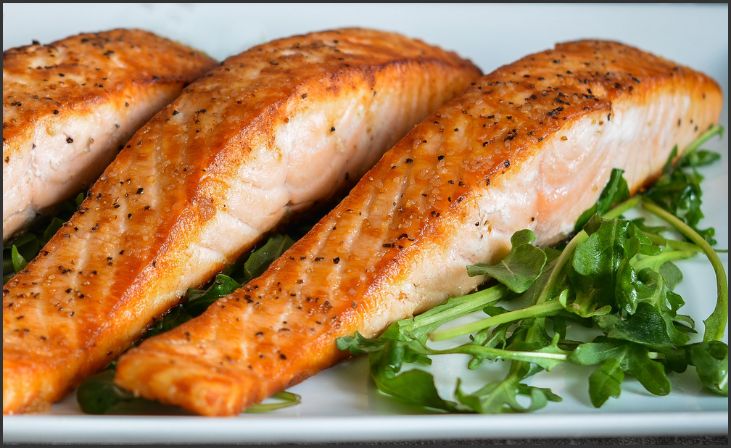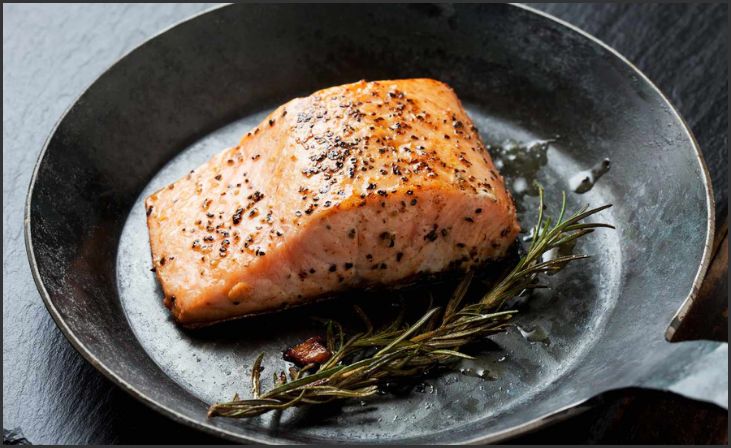How To Know When Salmon is Done – A Guide will help you determine when your salmon is cooked through. This guide will teach you how to check the internal temperature of your salmon, as well as what to look for in terms of visual cues.
After following the instructions in this guide, you’ll be able to tell with confidence when your salmon is done and avoid under or overcooking it.
What Is Salmon?

Salmon are saltwater fish that are native to the North Atlantic and Pacific Oceans. Although some varieties can be white, the distinctive brilliant orange color of its flesh in cooking makes it easy to identify.
Salmon and trout are sometimes confused with one another because of their somewhat similar appearances. Salmon and trout differ from each other in a number of ways, including habitat, nutritional value, flavors, and textures. As a result, salmon and trout cannot be used interchangeably.
Salmon has a distinct flavor that makes it impossible to mistake for any other fish. It has a very rich texture and a faint, mild meat flavor. There are several ways to prepare salmon, including grilling, roasting, smoking, and more.
You might find it challenging to choose what to serve with salmon because of its distinctive flavor. I find that it pairs incredibly well with fresh salad.
Wild vs. Farmed Salmon: How to Know What You’re Getting
When you’re perusing the seafood section at your local grocery store, you may notice that there’s often a distinction made between wild-caught and farmed salmon. So what’s the difference, and does it really matter? Here’s a look at the debate between wild vs. farmed salmon.
The main difference between wild and farmed salmon is, of course, where they’re raised. Wild salmon are caught in the open ocean, while farmed salmon are raised in man-made enclosures, typically in coastal areas.
While there are some benefits to farmed salmon, such as the fact that they’re more affordable than wild salmon, there are also some significant drawbacks. For example, farmed salmon are often given antibiotics and other chemicals to prevent disease. They may also be fed food that’s not natural to their diet, which can lead to unhealthy fat levels.
Additionally, the conditions in which farmed salmon are raised can be cramped and unsanitary, spreading the disease further. And because they’re typically not as active as wild salmon, they often have a higher fat level.
So, what’s the bottom line? Wild salmon is the way to go if you’re looking for the healthiest option. However, farmed salmon may be a more affordable option if you’re on a budget.
How to Tell if Salmon is Fresh
If you’re like most people, you love salmon. It is a tasty, healthful fish that may be prepared in various ways. But how can you tell if salmon is fresh?
There are a few things to look for when you’re buying salmon. First, check the color. Salmon should be a vibrant pink or orange color. If it’s a dull gray, it’s probably not fresh.
Next, smell the salmon. It should have a mild, pleasant smell. If it smells fishy or off, it’s not fresh.
Finally, touch the salmon. It should be firm to the touch, not mushy. If it’s starting to disintegrate, it’s not fresh.
If you’re not sure whether the salmon is fresh, it’s best to err on the side of caution and not eat it. Salmon is a perishable food, so it’s best to eat it as soon as possible after it’s caught.
How to Cook Salmon to Perfection Every Time

Salmon is a fillet of fish that is delicious, healthful, and ideal for a quick dinner. However, cooking salmon can be tricky, as it can easily become dry and overcooked. Follow these simple tips to cook salmon to perfection every time.
- Preheat the oven to the correct temperature.
Preheating the oven is crucial to cooking salmon correctly. The ideal temperature for cooking salmon is 350 degrees Fahrenheit. - Season the salmon.
Before cooking the salmon, season it with salt, pepper, and any additional seasonings of your choice. - Place the salmon skin-side down on a baking sheet.
Make sure to arrange the salmon on the baking sheet with the skin facing down. This will help to prevent the skin from becoming dry and overcooked. - Bake the salmon for 10-12 minutes.
Salmon should be baked for 10 to 12 minutes or until the fish is fully done. With a fork, the salmon should flake easily and be opaque. - Remove the salmon from the oven and enjoy!
Take the salmon out of the oven as soon as it is fully cooked, then serve.
5 Simple Ways to Make Salmon Taste Even Better
- Season your salmon with a fragrant spice blend.
- Cook your salmon skin-side down.
- Baste your salmon with a flavorful marinade.
- Sear your salmon in a hot pan.
- Serve your salmon with fresh and zesty salsa.
The Best Way to Store Salmon to Keep it Fresh
You most likely enjoy salmon if you’re like most people. It’s a delicious, healthy fish that can be cooked in various ways. But if you’re not careful, salmon can go bad quickly.
There are a few things you can do to keep your salmon fresh. First, if you’re buying fresh salmon, make sure to check the fish for signs of freshness. The eyes should be clear, and the flesh should be firm. If you’re buying frozen salmon, make sure to thaw it properly.
Once you have your salmon, it’s essential to store it properly. The best way to store salmon is in the refrigerator. Salmon should be kept at the refrigerator’s coldest section, typically the bottom shelf. In the refrigerator, salmon can be kept for up to two days.
Salmon can be frozen if it needs to be kept for longer than two days. In the freezer, salmon can be kept for up to six months. Then, when you’re ready to eat the salmon, make sure to thaw it properly.
Knowing how to keep salmon will allow you to always eat it fresh and deliciously!
How to Know When Salmon is Done Cooking
Salmon is a delicious, healthy fish that can be cooked in various ways. One of the most important things to know when cooking salmon is how to tell when it is done. Undercooked salmon can be tough and dry, while overcooked salmon can be mushy and fall apart. Here are some suggestions to help you prepare salmon consistently to perfection.
A meat thermometer is the best tool for determining when salmon is done cooking. Check the temperature by placing the thermometer into the thickest portion of the fish. The salmon is finished cooking when its internal temperature reaches 145 degrees Fahrenheit.
Examining the color is another technique to determine whether salmon is done. When salmon is cooked through, it will be an opaque pink color all the way through. If the salmon is still translucent in the middle, it needs to be cooked longer.
Finally, you can tell if salmon is done by touch. When cooked through, salmon will feel firm to the touch. If it is still mushy or falls apart easily, it needs to be cooked longer.
With these tips, you’ll be able to cook salmon perfectly every time. Enjoy!
3 Tips for Perfectly Grilled Salmon

You can grill, roast, braise, or smoke salmon, making it a flexible fish. It is also a healthy choice, packed with protein, omega-3 fatty acids, and vitamins. Here are three tips for grilling salmon that will result in perfectly cooked fish every time.
- Preheat the grill – This may seem obvious, but it is important to ensure the grill is hot before adding the salmon. Otherwise, the fish will stick to the grill and be difficult to flip.
- Use a grill basket – A grill basket is a metal basket with holes that allow heat to pass through. Salmon is the ideal food to grill with this item because it flips much more easily, and This prevents the fish from sticking to the grill.
- Oil the grill basket – Before adding the salmon to the grill basket, brush it with oil. This will keep the fish from sticking and add flavor to it.
After learning how to grill salmon, try one of these delicious dishes:
- Grilled Salmon with Lemon and Herbs
- Grilled Salmon with Honey and Sriracha
- Grilled Salmon with Avocado Salsa
Conclusion
Salmon can be cooked in a few different ways. One is to use a meat thermometer. Another is gently pressing down on the salmon fillet’s top with a fork. If the salmon is done, it will easily flake apart. Finally, you can also tell if salmon is done by its color. Cooked salmon should be an opaque pinkish-white color all the way through. It needs to be cooked longer if it is still translucent in the middle.
FAQs
The most reliable way to check the doneness of salmon is to use a fork or knife to gently flake the flesh. If it easily flakes apart and appears opaque throughout, it’s done. The color should be vibrant and uniform.
The FDA recommends cooking salmon to an internal temperature of 145°F (63°C). Use a food thermometer to ensure accuracy. Insert it into the thickest part of the fillet, avoiding the bone if present.
While cooking times can provide a rough estimate, it’s not foolproof. Factors like the thickness of the fillet, the cooking method, and the initial temperature of the fish can vary. Always use a thermometer or the flaking test to confirm doneness.

Leave a Reply